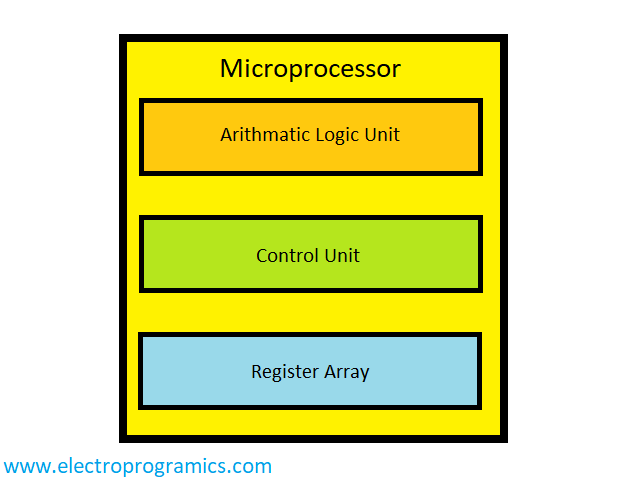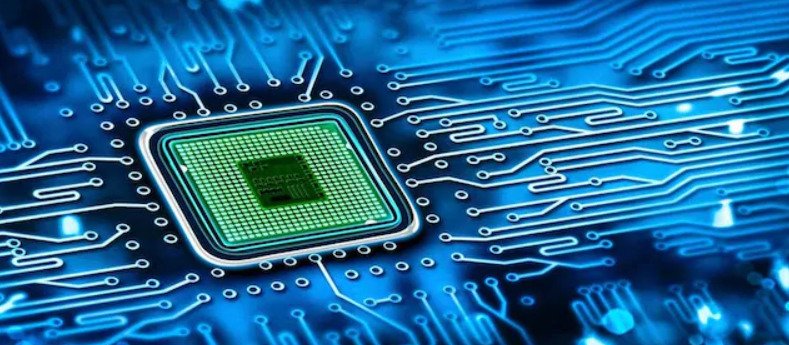A microprocessor is an electronic component fabricated on a semiconductor chip that has the ability to process user-defined inputs and give an output accordingly, following a program.
It is often considered as the brain of the computer or a circuit. It is used to process the data where the input is not predefined like video games, calculators, digital cameras, etc. Anything that needs a user-input or any circuit that is needed to be programmed, it is a microprocessor that has to be used in the circuit.
History of MicroProcessor
After the invention of the first computer ENIAC, the objective of scientists and engineers was to reduce the size and increase the efficiency of the computers. After the invention of transistors and later on, with the invention of Large Scale Integration or LSI technology, Intel company launched the first-ever microprocessor, which was named Intel 4004 in the year of 1971. It was a 4-bit microprocessor, which means it could only handle 4 bits of data at a time and could do simple mathematical operations. It was not very efficient but it was a revolutionary invention.
Later, Intel introduced two 8-bit microprocessors – Intel 8008 in 1972 and Intel 8085 in 1976. In the year of 1978, Intel launched 8086 which was a 16-bit microprocessor. This was faster than all the previous processor. Since then microprocessor technology has come a long way. Now we have microprocessors not only for mathematical calculations but also for graphics, signal processing, communications, etc.
Architecture
According to Von Neumann architecture, a modern computer consists of three main parts which are Input Device, Central Processing Unit(CPU), and Output Device. CPU again consists of a Control Unit, Arithmetic Logic Unit, and Memory Unit. A microprocessor acts as a CPU. The architecture of a microprocessor consists of three parts which are Arithmetic Logic Unit (ALU), Register Array, and Control Unit (CU).

The Arithmetic Logic Unit or ALU is nothing but the unit which processes the mathematical calculations like addition, subtraction, multiplication, division, etc. and logical operations like AND, OR, NOT, NAND, etc. Register array is the memory where the program is stored. This program decides the output for a particular input. And in the end, we have a Control Unit. This unit controls the processes happening inside a microprocessor.
Related Terms of Microprocessor
- Clock Speed: Clock speed refers to the number of instructions or operations performed per second.
- Word Length: Word length is the number of bits in a single data which a microprocessor can read.
- Bus: The connections inside a microprocessor are called Bus. They are of three types: data bus, address bus, and control bus.
- Bandwidth: Bandwidth means the number of bits processed per second by a microprocessor.
Types of Microprocessor
There are various types of microprocessors. Depending on their approach to processing microprocessors are mainly classified into two types:
- RISC: RISC stands for Reduced Instruction Set Computing. It has a simple circuit but needs a long program to execute the instructions. As it uses a simple circuit it requires less amount of RAM but needs more space in the register for long programs. Example: ARM, ARC microprocessor.
- CISC: CISC stands for Complex Instruction Set Computing. It uses a complex structure of transistor and a smaller program to perform its job. It requires more RAM than RISC and as it uses a smaller program it takes less space in the register. Example: Intel, AMD microprocessors.
Apart from these to we have different types of microprocessors depending on their application like: DSP for digital signal processing, GPU for graphics processing etc.
Microprocessor or Microcontroller
Some of us may have confusion between microcontrollers and microprocessors. They both are ICs, both of them can be programmed and both of them are used in computers. So, what is the difference between microcontrollers and microprocessors?
The basic difference between a microcontroller and a microprocessor is that a microprocessor does not have integrated RAM, ROM, or input-outputs but in case of a microcontroller, there is RAM, ROM, serial input-output pins and a microprocessor integrated inside the IC. This means that the microprocessor acts as a CPU but a microcontroller can act as a computer itself.
So, one might think that if we have integrated microprocessors inside a microcontroller why should we use a microprocessor separately? The answer is there are actually some disadvantages for microcontrollers. As for RAM, ROM, I/O pins, and the microprocessor is integrated inside a single chip, the productivity of a microcontroller becomes much lower. The speed of a microcontroller is much lesser than that of a microprocessor.
Advantages of Microprocessors
- Speed: Clock speed of microprocessors range of MHz to GHz resulting in high-speed processing.
- Low-cost: Microprocessor is a cheap and cost-efficient electronic component.
- Energy-Efficient: Microprocessors are made using MOS or Metal-Oxide Semiconductor technology. That is why they consume less power.
- Multipurpose Usage: Microprocessors can be used in every aspect of our lives. It is easy to modify and a single microprocessor can be used for multiple purposes.
Applications
Next, we have the applications of a microprocessor. It is necessary to know where the microprocessor should be used. Now microprocessor is an electronic component that has the ability to perform a certain task where the input is not predefined. Microprocessors give us the ability to program an electronic circuit. So, in any case, where we need user-defined input, we have to use a microprocessor. Example:
The very device you are reading this article uses a microprocessor to do its job. A mobile, a computer, a car navigation system, gaming consoles, smart TVs, radio or telecommunication systems, and many more devices use microprocessors. In the world of electronic gadgets, microprocessors can be found everywhere. Microprocessors have become an integrated part of our modern world.
Disadvantages of Microprocessors
- Programming: Microprocessor uses binary code or hex code or assembly level language which can be programmed by Embedded C. Embedded C is neither an easy language to learn nor an easy language to code in. So, programming the microprocessor is one of the hardest things in the whole process.
- Memory unit: The microprocessor does not have integrated RAM or ROM. We need to attach RAM and ROM, or memory units in general, externally.
- Heating: One of the biggest issues with the microprocessor is heating. This is why we can not use a microprocessor for a long time without a proper cooling system.
Conclusion
Though there are disadvantages, we can not ignore the massive usage of the microprocessor. The invention of the microprocessor gave the world of electronics a new direction. In the end, I want to repeat my words on what I wrote earlier that microprocessors have become an integrated part of the modern world.

